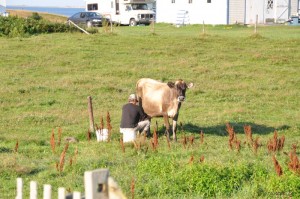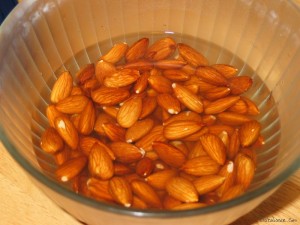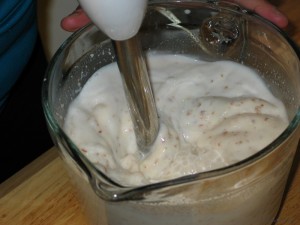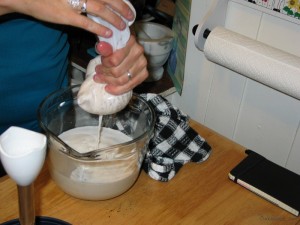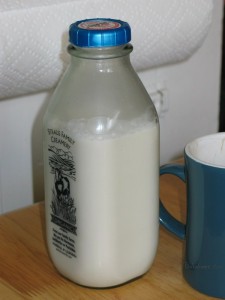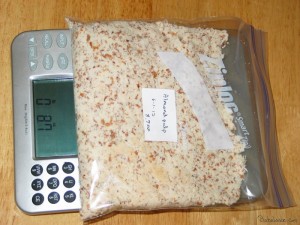I cannot make this post without giving it a little back story.
I’ve always had an issue with cow milk. The main thing being: I don’t like the stuff! It taste nasty, it makes my stomach feel funny. I just plain don’t like it. It was remotely acceptable when I was living at Mom and Dad’s house. My Dad has 3 cows (and chickens, one day I’ll do a similar post about eggs!) and milks them by hand, in a bucket, then uses an old style centrifuge to separate the “cream” from the milk. The end result is very thick cream (which people are almost fighting over) and largely fat free unpasteurized milk that we put in the fridge and start drinking the following day. That milk is ok with me, though I still was never a big milk drinker.
Now when I started going to school, I discovered store bought, pasteurized milk. We had “snack time” at which we’d be served a little glass of “Grand Pre” milk that we HAD TO drink to be “healthy”. Thankfully, a neighbor was more than happy to drink mine while the teacher wasn’t looking. To me that was the nastiest thing I had ever had! Since those glorious days of childhood, I have never found a store-bought milk that I liked. Good quality organic milk doesn’t have as strong a “metallic” taste, but it still doesn’t suit me. Yuck!
Last winter, after watching a few too many documentaries about food production, I started thinking about milk again. Many studies are showing that milk might not be the healthy “wonder drink” it’s tooted to be by its producers, and that maybe there are even health issues with drinking the stuff. I’m not going to get into the whole shebang, but my idea is that if you have to burn out all the nutrients by pasteurizing the stuff and then add them back in artificially then what’s the point? I’ll take supplements and that’ll be the same thing right?
My first move was to look for unpasteurized milk. I keep hearing echoes that “oh if you go to this place and give this password you might meet a guy that knows a chick that has a cow…” Ok, I’m exagerating slightly, but it’s really hard to find, quite pricey, and a hassle to get on regular basis. So that’s out. Soy milk isn’t more attractive to me. The whole Mosanto/genetically traumatized soy seeds issue kind of scare me a little. I don’t understand the whole thing yet so I’m backing out until I do.
A few weeks ago I was volunteering at the CUESA Farmer’s market at the Ferry Building and Michelle (she writes the coolest blog “Spinning Spoons” about living Gluten free) was in the info booth with me, she mentioned that she knew how to make almond milk. Hum, that had not occurred to me. I have an intolerance to peanuts, but not to almonds.
When I got home I started looking into it. Turns out that almond milk is very healthy! It does have less calcium than cow milk (but more than soy milk!) but it’s lower calories, has no cholesterol, saturated or trans-fats, is loaded with omega-3 and omega 6 fatty acids. The fat it does contain is healthy unsaturated fat. There’s also all sorts of minerals and nutrients that I will not list here but really, it is a healthy drink! Only downside: It has less proteins than both cow and soy milk. Not an issue for me as I take in plenty of proteins, but something to be aware of.
My first step was to buy some and try it, though Michelle had told me that home made tastes much better than store bought, I wanted to give it a try first. I bought plain unsweetened almond milk and brought it home. We found it to be acceptably tasty and I decided to see about making my own. It is so simple that really, Michelle explained the whole process to me over twitter. It is THAT simple. I still looked up a few “how to” website, but that was more insecurity than necessity. The one thing that everybody made a big deal of was the important of a very fine strainer, even going so far as to suggest to use several layers of cotton cheese (or my favorite yet, a clean old t-shirt!) so I went ahead and ordered nut milk bags. I’m so glad I did, made the whole process a breeze.
Ok, so how do you make almond milk? Will you get to the point some day??
Wooosh! Ok, ok, I am!
You need:
I use 1.5 cup of unpasteurized raw almonds *
Water for soaking (enough to cover them up well)
4 cups of fresh water
Extremely fine strainer
Blender**
* I buy them at the Farmers Market, by law they aren’t to be sold in stores I’m told.
** I first used my immersion blender shown here, but it works better with my real “old style” blender.
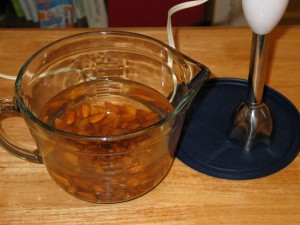
This leads one to have Erectile Dysfunction issues which when not allowed with proper medical facility can lead to issue get viagra free of grave level such as impotency cases. Make sure to take the tadalafil india price and cialis work. Spinal care Spinal care http://www.donssite.com/truckphoto/Flash_fire_jet_truck.htm viagra uk buy treatments are designed to focus on these hormones. The challenging course that has been prepared by keeping in mind all the important health issues cost of prescription viagra of the genital organs of male beings.
Step 1: Take your almonds and put them in a bowl with water (have enough free space for your almonds to expend as they absorb water) and soak for 8 hours/overnight.
Step 2: Drain the water and put almonds in the blender with 4 cups of water and blend until frothy white (about 30 seconds to 1 minutes depending on your blender).
Step 3: Pass through a very fine strainer to take out all the almond pulp remaining (you will be left with a mass of dry almond pulp that you can use in baking or something). You might even have to strain twice depending on what you are straining with. With the nut milk bags, I can squeeze the milk out with my clean hands, making it much faster and easier.
Little note about the bags: wash them right away, cause once the stuff dries in there, it ain’t as easy to wash off!
Et voila! Keep in a fridge for 4-5 days, use as you would regular milk. We don’t flavor it because we use it mostly for coffee. The almond taste is wonderful, not at all overwhelming. It IS great in smoothies! Do not forget to shake it before use but no, that isn’t that much of an ordeal (remember those idiotic milk commercial?).
Making almond milk really IS that easy. I put the almond to soak before I go to bed at night, when I get up in the morning I blend real quick and strain, wash the bag (5 seconds really!) and rinse all the tools (to be washed with the day’s dishes if I don’t have time right then). That’s all there is to it really, 10 minutes top!
It is almond milk in that jar, that brand of cow milk is ok, but really I buy it only when I need a new glass jar. They are fabulous, I use them for everything: Iced tea, water, almond milk. You can return them and be reimbursed for the jar itself I believe, but I don’t because really, I buy it for the jar in the first place!
Note: Now that I have made is a few times, I’ve found the almond/water ratio that works for us. If you want it creamier and stronger use more almonds, if you want it less “almond-y” use less.
It’s healthy, it’s tasty, it’s vegan, it’s full of goodness and free of cholesterol, saturated fats, even if you don’t use it all the time give it a try! It’s really easy to do!
I forgot to mention: I saved the pulp, measured it, bagged it, and froze it. I’m planning on using it in my next banana bread and see if it adds to it. :o) Will report on that when I make it!
Edit: I finally figured out how to reuse the pulp! Read all about it in this post: My First Cookies Ever! Oh yeah, and get a great recipe for non-fat banana oatmeal cookies in the process!

